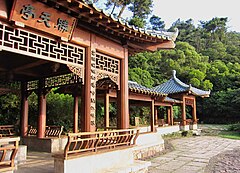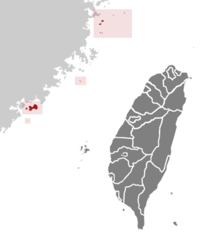Fujian (Republika Chińska)
| Prowincja | |||
 | |||
| |||
| Państwo | |||
|---|---|---|---|
| Siedziba | Jincheng | ||
| Powierzchnia | 180 km² | ||
| Populacja (2014) • liczba ludności |
| ||
| • gęstość | 777 os./km² | ||
Położenie na mapie | |||
| Strona internetowa | |||
| Portal | |||
Prowincja Fujian (chiń. 福建省; pinyin Fújiàn Shěng; pe̍h-ōe-jī Hok-kiàn-séng) – wyspiarska część chińskiej prowincji Fujian, która po powstaniu Chińskiej Republiki Ludowej nie znalazła się pod jej kontrolą, pozostając w rękach Kuomintangu. Stanowi obecnie obok prowincji Tajwan jedną z dwóch prowincji Republiki Chińskiej na Tajwanie. Według tajwańskiego punktu widzenia z powodu zajęcia kontynentalnej części prowincji Fujian przez komunistów w 1949 roku nastąpiło jedynie przeniesienie siedziby władz lokalnych[1].
Prowincja obejmuje obszar 180 km² i liczy ok. 140 000 mieszkańców[2]. Dzieli się na 2 powiaty, w skład których wchodzą 3 gminy miejskie i 7 gmin. Jej stolicą jest Jincheng. W latach 1956-1996 z uwagi na obawę przed ewentualną inwazją ze strony ChRL prowincja znajdowała się pod zarządem wojskowym, a jej władze rezydowały wówczas w Xindian na Tajwanie[1].
Przypisy
- ↑ a b Fujian Provincial Government Overview (ang.). fkpg.gov.tw. [dostęp 2010-07-01]. [zarchiwizowane z tego adresu (5 września 2014)].
- ↑ 鄉鎮市區戶口數 – 中華民國103年12月底 (chiń.). 內政部社會司. [dostęp 2015-11-22].
Media użyte na tej stronie
Autor: User:Energiya, Licencja: CC-BY-SA-3.0
Location of the Kinmen and Lienchiang counties of the Republic of China relative to Taiwan and mainland China. Made by uploader using Image:Taiwan Strait.png as base map. Borders were taken from zh:User:試吃那人's locator maps for Taiwanese counties. The faded box idea was borrowed from User:Nichalp's locator maps for Indian states.
Autor: Rutger van der Maar, Licencja: CC BY 2.0
Place: Nangan, Matsu Islands
The Matsu islands are a minor archipelago of 36 islands and islets in the East China Sea and administered by the Republic of China (Taiwan). The Matsu islands together form the county of Lienchiang, but most of Liangjiang County (same name, different spelling) is under control of the People's Republic of China. Linear distance from mainland China is less than 20 km.
Mainlanders from Fujian and Zhejiang started migrating to the islands during the Yuan Dynasty. The popular net fishing industry had established the base for development of Fuao settlement and industrial development of the region over several hundred years.
During the early Qing Dynasty, pirates gathered here and the residents left temporarily. In contrast with Taiwan and Penghu, the Matsu Islands were not ceded to the Japanese Empire via the Treaty of Shimonoseki in 1895. Neither were they occupied by Japanese troops during World War II because they were not important militarily. Due to its strategic location for the only route for spice road, the British established the Dongyong Lighthouse in Dongyin Island in 1912 to facilitate ships navigation.
In 1911, the Qing Dynasty was toppled after the Xinhai Revolution on 10 October 1911 and the Republic of China (ROC) was established on 1 January 1912. Matsu Islands was subsequently governed under the administration of Fukien Province of the ROC. On 1 August 1927, the Nanchang Uprising broke out between the ruling Nationalist Party of China (KMT) and Communist Party of China (CPC) which marked the beginning of Chinese Civil War. After years of war, the CPC finally managed to take over mainland China from KMT and established the People's Republic of China (PRC) on 1 October 1949 which also covers the Lianjiang County of Fujian. The KMT subsequently retreated from mainland China to Taiwan in end of 1949.
After their retreat, the KMT retained the offshore part from the original Lianjiang County located on Matsu Islands, and also all of Kinmen County. In July 1958 the PRC began massing forces opposite the two islands and began bombarding them on 23 August, triggering the Second Taiwan Strait Crisis. On 4 September 1958, the PRC announced the extension of its territorial waters by 20 kilometres (12 mi) to include the two islands. However, after talks were held between the USA and PRC in Warsaw, Poland later that month, a ceasefire was agreed and the status quo reaffirmed.
The phrase "Quemoy and Matsu" became part of American political language in the 1960 U.S. presidential election. During the debates, both candidates, Vice-President Richard Nixon and Senator John F. Kennedy, pledged to use American forces if necessary to protect Taiwan from invasion by the PRC, which the United States did not recognize as a legitimate government. But the two candidates had different opinions about whether to use American forces to protect Taiwan's forward positions, Quemoy and Matsu, also. In fact, Senator Kennedy stated that these islands - as little as 9 kilometres (5.5 mi) off the coast of China and as much as 170 kilometres (106 mi) from Taiwan - were strategically indefensible and were not essential to the defense of Taiwan. On the contrary, Vice-President Nixon maintained that since Quemoy and Matsu were in the "area of freedom," they should not be surrendered to the Communists as a matter of "principle."
Self governance of the county resumed in 1992 after the normalization of the political warfare with the mainland and the abolishment of Battle Field Administration on 7 November 1992. Afterwards, the local constructions progressed tremendously. In 1999, the islands were designated under Matsu National Scenic Area Administration. In January 2001, direct cargo and passenger shipping started between Matsu and Fujian Province of the PRC. Since 1 January 2015, tourists from mainland China could directly apply the Exit and Entry Permit upon arrival in Matsu Islands. This privilege also applies to Penghu and Kinmen as means to boost tourism in the outlying islands of Taiwan.
Source: en.wikipedia.org/wiki/Matsu_Islands
In 2013 I had the opportunity to visit the largest of the Matsu islands, Nangan, as a friend of mine is a teacher at a primary school on the island.Provincial emblem of Fujian Province, the Republic of China





